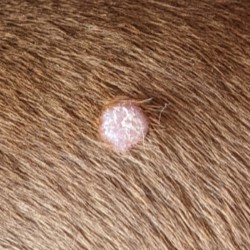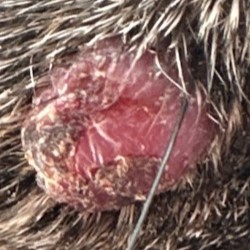Canine cutaneous histiocytoma is a common type of skin lump in dogs, especially those less than 3 years old. Most of the time histiocytomas cause no problems and will disappear within 3-4 weeks.
Usually, a histiocytoma is a raised lump or spot on the skin that causes no discomfort. If there is soreness, inflammation or the lump is growing rapidly, a fine needle aspirate can be done to rule out other problems. If a histiocytoma has become injured or infected, surgery to remove it will usually resolve the problem.
Overview
What is a histiocytoma in dogs?
- Histiocytes are a special type of defensive cell that sits under the skin, ready to identify and lead the charge against any invaders.
- Sometimes, histiocytes will clump together in the skin and cause a lump or mass to form. The reason for this is still unknown.
- Over time, other defensive cells will infiltrate the lump and break it apart. Most histiocytomas will be gone after a few weeks.
- Cells of the histiocyte family can cause other types of lumps as well, but these have a very different appearance and often affect organs other than the skin.

- Example of a histiocytoma in a dog

- Another histiocytoma
Symptoms
Symptoms of histiocytoma in dogs
- Raised lump or spot on the skin, often pink in colour.
- Usually moves with the surrounding skin, meaning it is not attached to anything underneath.
- Sometimes a crust or scab will be present on the surface.
- As the lump breaks apart over time, a sore or infection may develop and need to be treated.
Risk
Dogs at higher risk for histiocytoma
- Most histiocytomas happen in dogs younger than 3 years old, but they can happen at any age.
- Boxers and Dachshunds are more commonly affected.
Diagnosis
Diagnosis of histiocytoma in dogs
A histiocytoma can be suspected on examination, but to know for sure, tests are required. There are two main options:
- Fine needle aspirate: this is usually simple to do and causes little discomfort, but will not always be conclusive.
- Biopsy: if the fine needle aspirate is inconclusive, a biopsy may be done. This requires anaesthesia and surgery but is the most reliable way to get an accurate and definitive answer.
Vet treatment
Vet treatment of histiocytoma in dogs
If a histiocytoma is strongly suspected or confirmed and it’s not causing any problems, your vet may recommend keeping an eye on it. Most histiocytomas break apart or are absorbed within weeks. Surgery will be recommended if the lump:
- Causes discomfort or pain
- Becomes infected and is not responding to treatment
Surgery is usually effective and regrowth in the same place is rare.
Home treatment
Home treatment of histiocytoma in dogs
Histiocytomas are usually not painful or itchy, but you want to make sure your dog isn’t rubbing or scratching the area.
Your vet may recommend monitoring the lump.
If a scab or discharge develops, it may help if you bathe the lump with saline (1 tsp salt/500ml cooled boiled water) or a gentle antiseptic such as a dilute chlorhexidine solution (the final concentration should be 0.2-0.4%) twice per day.
Prevention
Prevention of histiocytomas in dogs
At the moment, there is no way to prevent histiocytomas.
When to worry
When to worry about a histiocytoma on your dog
It’s best to have a vet check any lumps on your dog so they can advise you about what to monitor or if testing is necessary. If no treatment is recommended, speak to a Joii Vet if you notice any of the following:
- The lump becomes irregular in shape or texture
- The skin over or around the lump becomes red or black
- The lump starts growing rapidly or swelling develops around it
- Your dog starts paying attention to the lump
- There is discharge coming from the lump
Our Joii vets are available 24 hours a day for advice and can help you with all the concerns above.












